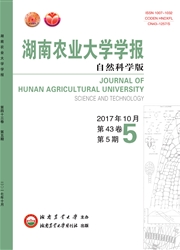

 中文摘要:
中文摘要:
为解决云南稻作遗传基础狭窄和地方稻种难以利用等问题,以548份云南稻核心种质和云南主栽籼稻品种滇屯502、粳稻品种杂合系35配制的杂种F2(498份)为材料,按籼粳间、稻作区间进行云南稻核心种质杂种后代形态多样性鉴定与分类研究.结果表明:1)杂种F2具有丰富的形态多样性,结实率、实粒数、秕粒数、穗颈长等性状都表现出较大的变异,平均多样性指数也较高.2)籼粳间、稻作区间单一性状变异趋势基本一致,但多样性指数存在一定差异.3)通过聚类分析,可将供试材料划分成4个性状不同的类群,各类群的形态性状差异明显,有利于育种目标的选择.
 英文摘要:
英文摘要:
To solve the problems of narrow hereditary basis and conquer difficulties in application of local rice landrace, 498 strains of F2 were chosen as material, after hybriding 548 strains of Yunnan rice core idioplasm with Yunnan mainly-cultivated indica rice, Diantun 502(Oryza satica), and with combination line 35(Oryza satica) from japonica flee and indica rice, morphological diversity of hybrid generations of Yunnan rice core idioplasm was identified and classified in terms of japonica rice and indica rice and rice land area. The result showed that: 1) The morphological diversity of hybrid F2 was high among accessions assessed, and its seed-setting rate, filled grain no.per panicle, unfilled grain no.per panicle, peduncle length presented a great morphological genetic variation,in acldition, its average diversity index was also high. 2) The variation trend of single characters is consistent between indica and japonica and rice cropping region; there was a great difference on diversity index among characters. 3) Through a cluster analysis, the material could be divided into 4 class groups with different characters in which differences in shape character was obvious. It would be advantageous to the breeding choice.
 同期刊论文项目
同期刊论文项目
 同项目期刊论文
同项目期刊论文
 期刊信息
期刊信息
